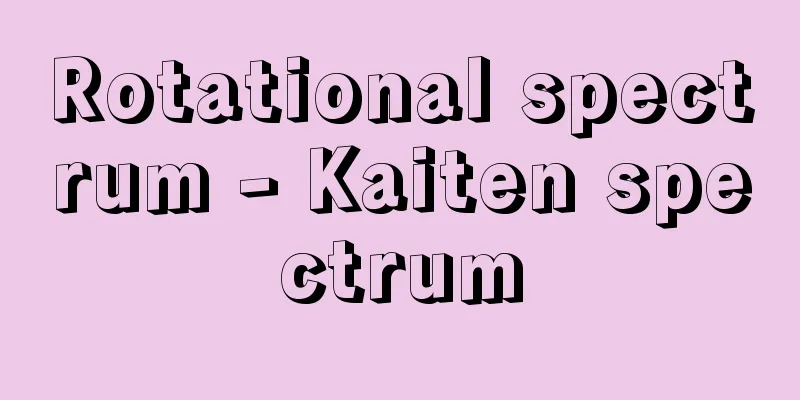Biscuit - Biscuit (English spelling)

|
Western-style baked goods made primarily from wheat flour. Sugar, oils, milk, eggs, flavorings, etc. are added to wheat flour, molded, and baked in an oven. In a broad sense, biscuits also include cookies, sables, crackers, rusks, and hardtack. The word is said to originate from the Latin bis coctus (meaning twice baked). It was developed in England, where bread was sliced thinly and baked again to preserve it. Modern sweet biscuits are called biscuits in England and sables in France, while cookies are the general name in America. In America and France, biscuits (biscuis) refer to hard-baked bread with little sweetness. However, in Japan, biscuits, cookies, and sables are all mixed together, with no clear difference between them. [Tomomi Kono and Yonago Yamaguchi] historyAs the etymology suggests, the original form of biscuit was similar to bread, and was a portable food that was preserved by baking it twice. Around the 15th century, biscuits were used on sea voyages and in the military in Europe. In fact, in England there was a term "ship biscuit," and it was an important food for sea voyages. Biscuits were originally a type of dry bread without added sugar, but they also developed as sweets, and in England they began to be industrialized and mass-produced in the 18th century. They were introduced to Japan by the Portuguese in the late 16th century under the name "biscout." From the end of the Edo period to the Meiji era, they were also considered as military rations. The first person to make biscuits as a sweet in Japan was Yonezu Matsuzo of Fugetsudo in 1875 (Meiji 8). [Tomomi Kono and Yonago Yamaguchi] kindsBiscuits are classified into three types based on the ingredients and manufacturing method: hard, soft, and fancy. Hard biscuits are relatively hard to the touch because they contain less fat and sugar. They are characterized by an engraved pattern on the surface and pinholes for venting gas. Soft biscuits are high in fat and sugar and have a crumbly texture. They have a raised pattern on the surface and no pinholes. Fancy biscuits have more sugar and fat than soft biscuits and come in a wide variety of shapes and side ingredients. Among soft and fancy biscuits, those with a handmade appearance and a wide variety of shapes and ingredients are called cookies or sables. In addition to biscuits, JAS (Japan Agricultural Standards) biscuits also include crackers (including hardtack and pretzels), cut bread (similar to bread dough (kiji) baked in a biscuit oven), and pies (confections made from puff dough baked in a biscuit oven, also called puffs). [Tomomi Kono and Yonago Yamaguchi] Manufacturing methodBiscuits are made by mixing flour with sugar, fat, dairy products (milk or milk powder), eggs, water, flavorings, etc. to make dough, which is then cut into shapes using various methods. The dough is then baked in an oven and processed by sandwiching jam or coating it with chocolate. Most biscuits are made in automated factories. Cookies are made in almost the same way as biscuits, but the dough is made in a different way, and they contain more sugar and fat, and use additional ingredients such as nuts and dried fruits. They are also made in various shapes to give them a handmade feel. There are three main ways to make them at home: cut-out cookies, which are similar to biscuits; drop cookies, which are made by squeezing dough onto a baking sheet; and icebox cookies, which are made by rolling dough into a bar shape, cooling it, cutting it into thin slices, and baking it. Cut-out cookies contain less fat than the other two. Crackers are also made in factories, and are often less sweet and salty, with dough left to ferment with yeast. Soda crackers, which are made with yeast and sodium bicarbonate (baking soda), are the most common, and other crackers, such as cheese crackers, graham crackers, and oatmeal crackers, are made with additional ingredients. They can be eaten as a main meal, snack, or appetizer with other foods (vegetables, jam, ham, etc.). Crackers also come in a variety of other shapes, such as thin sticks, rope knots (pretzels), and small fish shapes. Biscuits are primarily sweets, but there are a wide variety of products, including salty snacks, appetizers, and baby products. In recent years, semi-dry biscuits, something between biscuits and cakes, have also been produced. [Tomomi Kono and Yonago Yamaguchi] "495 Dried Confections" by Mitsuru Sakaki, produced and supervised by Yoshio Watanabe (1998, Morris Company, Seiunsha Publishing)" ▽ "The Story of the First Western Confectionery" by Kikujiro Yoshida (Heibonsha Shinsho) [References] | | |Source: Shogakukan Encyclopedia Nipponica About Encyclopedia Nipponica Information | Legend |
|
小麦粉を主原料にした洋風焼き菓子。小麦粉に糖類、油脂類、牛乳、卵、香料などを加え、成型してオーブンで焼いたもの。広義にはクッキーcookie、サブレーsablé、クラッカーcracker、ラスクrusk、乾パンなどもビスケット類の仲間である。語源はラテン語のbis coctus(二度焼きという意味)といわれている。イギリスで発達したもので、パンを保存するために薄く切ってもう一度焼いたのが始まりである。現代の甘味のあるビスケットは、イギリスではビスケット、フランスではサブレーとよばれ、アメリカではクッキーが一般名である。アメリカやフランスでビスケット(ビスキュイ)といえば、甘味の少ない堅焼きのパン状のものを意味している。しかし、日本ではビスケットとクッキーとサブレーが混在し、明確な違いはない。 [河野友美・山口米子] 歴史語源にあるようにビスケットの原形はパンに近いもので、二度焼くことにより保存性をもたせた携帯食であった。15世紀ごろ、ヨーロッパでは船旅や軍隊用としてビスケットを用いている。実際にイギリスではシップビスケットship biscuitという語があり、船旅用の食糧として重要なものであった。ビスケットは本来砂糖を加えない乾パン風のものであったが、菓子としても発達し、イギリスでは18世紀に工業化して大量生産を始めた。日本へは16世紀後半にポルトガル人がビスカウトという名で伝えた。江戸末期から明治時代には兵糧食として検討されたこともある。菓子としてのビスケットを日本で最初につくったのは凮月(ふうげつ)堂の米津(よねづ)松造で1875年(明治8)である。 [河野友美・山口米子] 種類原料配合と製法からハードビスケット、ソフトビスケット、ファンシービスケットの三つの系統に分類される。ハードビスケットは、脂肪、糖分が少ないので口あたりが比較的固い。表面に彫込み模様とガス抜きの針穴があるのが特徴である。ソフトビスケットは、脂肪、糖分が多く、砕けやすい食感がある。表面に浮き出し模様があり、針穴はない。ファンシービスケットは、ソフトビスケットよりさらに糖分や脂肪が多く、形や副材料も豊富である。ソフトビスケットやファンシービスケットのなかで手作り的な外観があり、形や材料が変化に富んでいるものをクッキーやサブレーという。JAS(ジャス)(日本農林規格)のビスケット類にはビスケットのほかにクラッカー(乾パン、プレッツェルも含む)、カットパン(ビスケット用オーブンで焼いたパン生地(きじ)に近いもの)、パイ(ビスケット用オーブンで焼いたパイ生地の菓子でパフともいう)なども含まれている。 [河野友美・山口米子] 製法ビスケットは小麦粉に糖類、脂肪類、乳製品(牛乳や粉乳)、卵、水、香料などを配合して生地をつくり、いろいろな成型法で型抜きをする。これを焼き釜(がま)で焼き上げ、ジャムなどを挟む(サンドタイプ)、チョコレートなどをコーティングするなどの加工仕上げがされる。ほとんどのビスケットがオートメーション化された工場で製造されている。クッキーはビスケットと製法はほとんど同じで、生地の配合が変わり、糖分や脂肪が多く、ナッツ類、乾燥果実などの副材料が用いられる。形も手作りの雰囲気を出すため、いろいろな形につくられる。家庭での作り方には大別して、ビスケットに近い型抜きクッキー、生地を天板に絞り出すドロップクッキー、生地を棒状に丸めて冷やし、薄く切って焼くアイスボックスクッキーの三つがある。型抜きクッキーは他の二つに比べ脂肪含量が少ない。クラッカーも工場でつくられ、甘味が少なく塩味のもので、生地をイースト発酵させるものが多い。イーストと炭酸水素ナトリウム(重曹)を併用したソーダクラッカーが代表的なもので、そのほか副材料からチーズクラッカー、グラハムクラッカー、オートミールクラッカーなどがある。主食やスナック食、おつまみとして他の食品(野菜、ジャム、ハムなど)と食べる。クラッカーにはそのほか、細いスティック状、ロープの結び目状(プレッツェル)、小さい魚形など多様なものがある。 ビスケット類は主として菓子であるが、塩味のスナック食やおつまみ用のもの、育児用と幅広い製品がある。近年、半生(なま)タイプと称されるビスケットとケーキの中間的なものも製品化されている。 [河野友美・山口米子] 『渡辺義雄製作・監修、榊満著『乾き菓子495』(1998・モーリス・カンパニー、星雲社発売)』▽『吉田菊次郎著『洋菓子はじめて物語』(平凡社新書)』 [参照項目] | | |出典 小学館 日本大百科全書(ニッポニカ)日本大百科全書(ニッポニカ)について 情報 | 凡例 |
>>: Biskra - Biskra (English spelling)
Recommend
Chrysopa intima (English spelling) Chrysopaintima
…Udonga (Udonge) [Shigehiko Tsukaguchi]. … *Some ...
Kato Umaki
A poet and scholar of Japanese classics in the mi...
Comb-drawn earthenware
…In the Kyushu region, Sugu-style pottery is repr...
Aoki [village] - Aoki
A village in Chiisagata County in central eastern ...
Paracaesio caeruleus (English spelling) Paracaesiocaeruleus
… [Makoto Shimizu]. . … *Some of the terminology ...
Roquefort cheese
…It is aged for 2 to 3 months and has a slightly ...
Indigo paper
〘Noun〙① Japanese paper soaked in the juice of dayf...
Tughluq Timur (English spelling)
In this situation, conservative Mongolians who op...
Gilbertus Porretanus
1076‐1154 His French name was Gilbert de la Porrée...
Tribus - Tribus (English spelling) Latin tribus
A subdivision of the ancient Roman people. During...
Leaf trace
… When leaves grow laterally from a stem, the ste...
Rahewin
…Another historical work he wrote in his later ye...
Nordenskield
Swedish explorer and geographer. Baron. His name w...
Merit and demerit - Koukakaku
A Taoist book. In this book, the author grades hi...
Aluminizing - Aluminizing
...Due to the nature of the treatment, the coatin...









![Louis [IX] - Louis](/upload/images/67cd2f517ada3.webp)